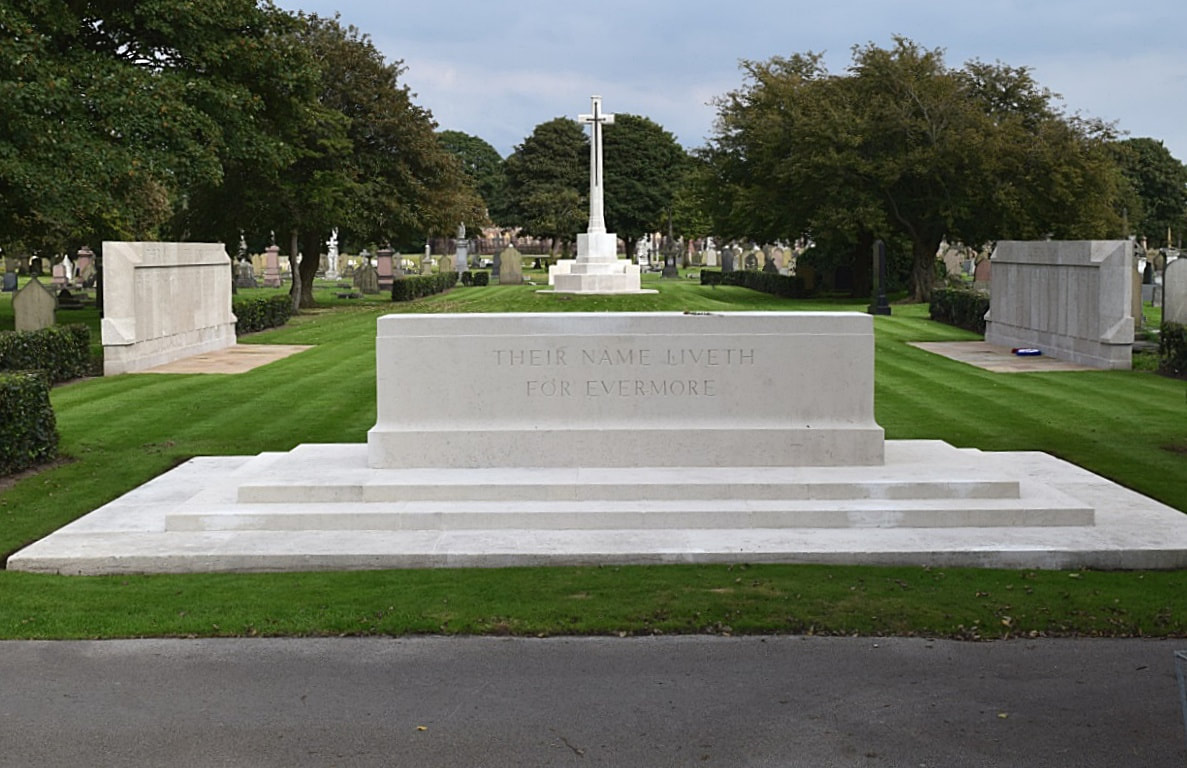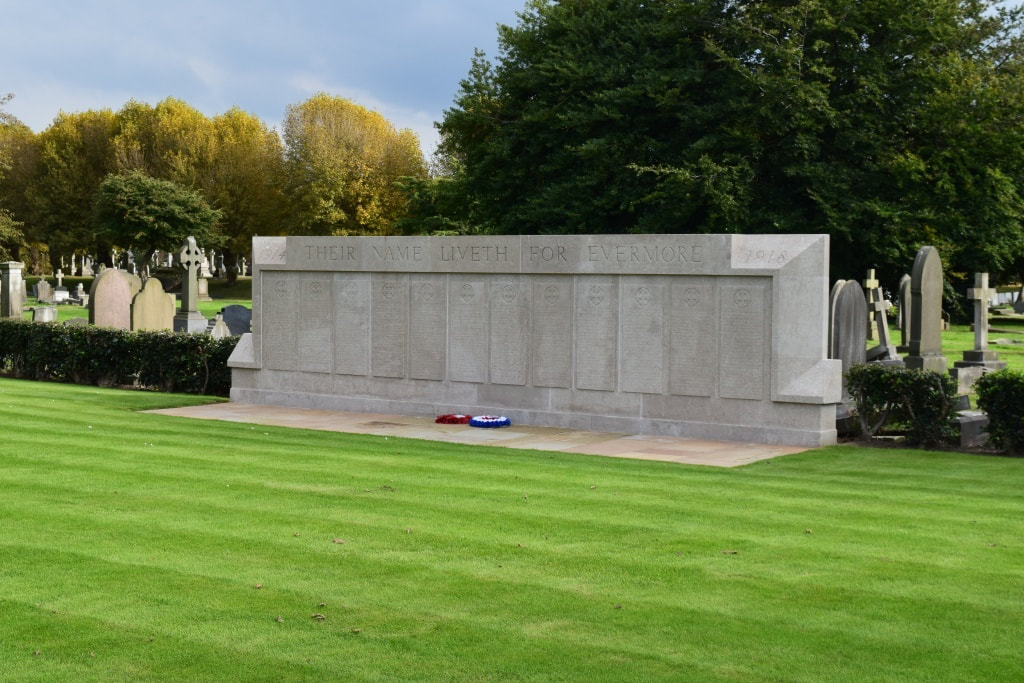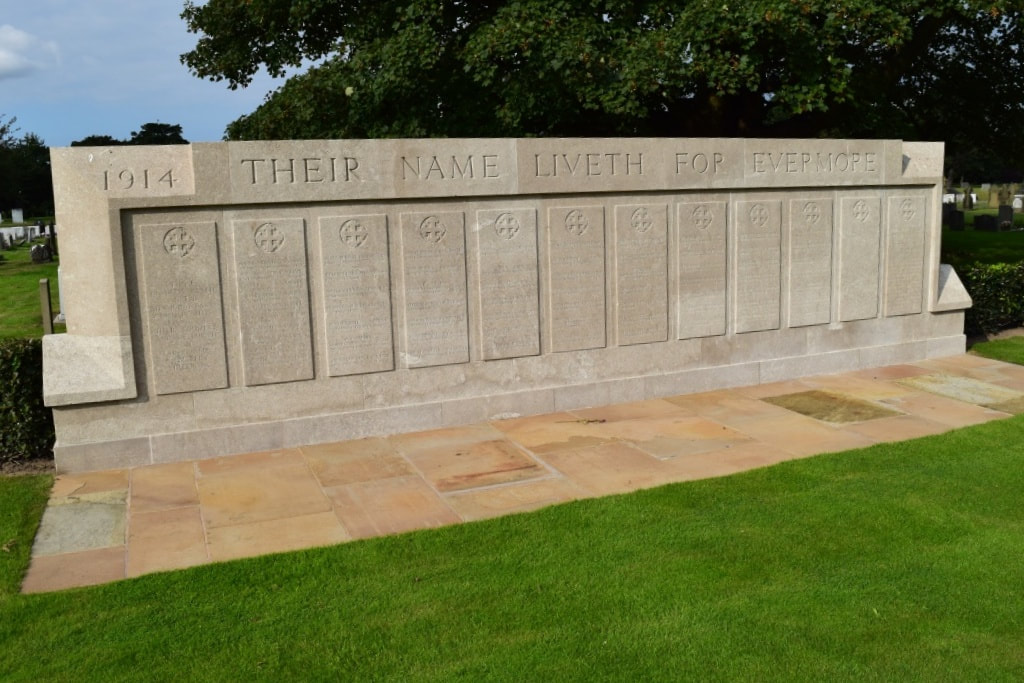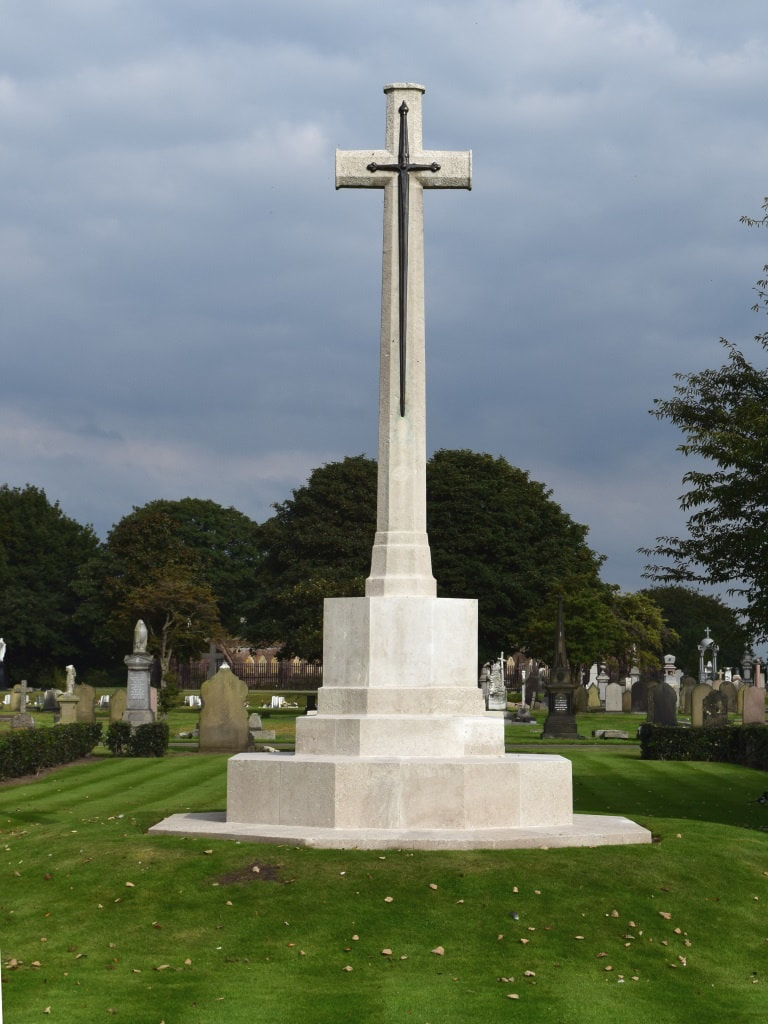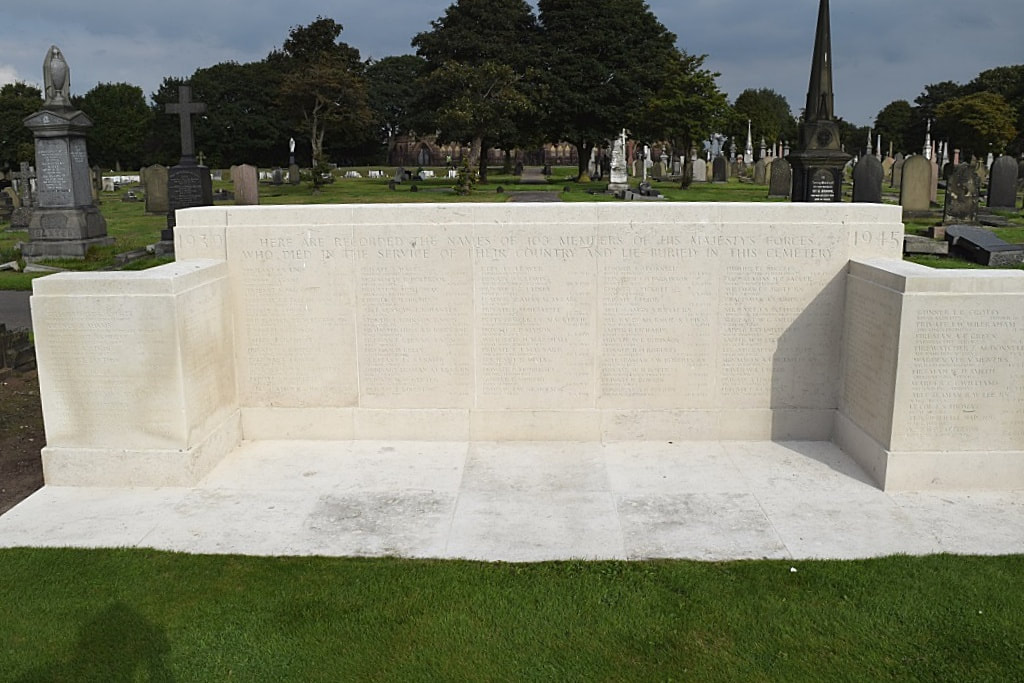LIVERPOOL (ANFIELD) CEMETERY
Merseyside
England
GPS Coordinates: Latitude: 53.43578, Longitude: -2.95783
Location Information
Anfield Cemetery is located along Priory Road in Anfield, Liverpool.
Historical Information
In December 1914, Liverpool became one of the 21 Auxiliary Patrol Bases and in February 1915, the base of the 10th Cruiser Squadron. During the Second World War, Liverpool was headquarters of Western Approaches Command and a manning depot for officers and men of the Merchant Navy who agreed to serve with the Royal Navy for the duration of the war.
Liverpool (Anfield) Cemetery contains burials of both wars. The majority are in two war graves plots in Section 5, with Screen Walls bearing the names of those buried there. The rest of the war burials are scattered throughout the cemetery.
There are 453 Commonwealth servicemen of the First World War buried or commemorated in the cemetery. Included in this total are 17 casualties who are commemorated by name on the Screen Wall as their graves in Bootle (St Mary) Churchyard and Liverpool (St James) Cemetery could no longer be maintained. Second World War burials number 459 including 2 unidentified British soldiers. There is also another Screen Wall memorial to those whose burials are not marked by headstones. There are also 67 war graves of other nationalities, the majority of them Dutch and Norwegian Merchant seamen, and there are 9 non war service burials here.
Total Commission Burials: 1,002.
World War One Identified Casualties: United Kingdom 440, Canada 10, Australia 5, India 1, South Africa 1. Total 457.
World War Two Identified Casualties: United Kingdom 460, Netherlands 33, Norway 29, Belgium 4, Australia 2, Canada 1, Russia 1. Total 530.
Anfield Cemetery is located along Priory Road in Anfield, Liverpool.
Historical Information
In December 1914, Liverpool became one of the 21 Auxiliary Patrol Bases and in February 1915, the base of the 10th Cruiser Squadron. During the Second World War, Liverpool was headquarters of Western Approaches Command and a manning depot for officers and men of the Merchant Navy who agreed to serve with the Royal Navy for the duration of the war.
Liverpool (Anfield) Cemetery contains burials of both wars. The majority are in two war graves plots in Section 5, with Screen Walls bearing the names of those buried there. The rest of the war burials are scattered throughout the cemetery.
There are 453 Commonwealth servicemen of the First World War buried or commemorated in the cemetery. Included in this total are 17 casualties who are commemorated by name on the Screen Wall as their graves in Bootle (St Mary) Churchyard and Liverpool (St James) Cemetery could no longer be maintained. Second World War burials number 459 including 2 unidentified British soldiers. There is also another Screen Wall memorial to those whose burials are not marked by headstones. There are also 67 war graves of other nationalities, the majority of them Dutch and Norwegian Merchant seamen, and there are 9 non war service burials here.
Total Commission Burials: 1,002.
World War One Identified Casualties: United Kingdom 440, Canada 10, Australia 5, India 1, South Africa 1. Total 457.
World War Two Identified Casualties: United Kingdom 460, Netherlands 33, Norway 29, Belgium 4, Australia 2, Canada 1, Russia 1. Total 530.
Images in gallery below used with the permission of the Commonwealth War Graves Commission
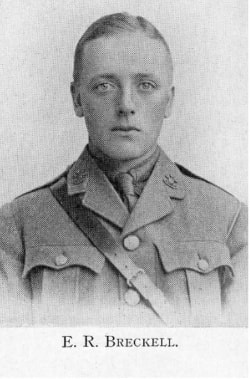
Lieutenant
Edward Ryder Clayton Breckell
3rd Bn. South Lancashire Regiment
8th February 1918, aged 29.
IV. C. 2179.
Son of Edward J. B. and Emilia Mary Breckell, of 12, Alexandra Rd., Waterloo, Liverpool.
The information below supplied by 'The Ellesmerian Club', the alumni organisation for Ellesmere College where Edward was a pupil.
Edward Ryder Clayton Breckell
3rd Bn. South Lancashire Regiment
8th February 1918, aged 29.
IV. C. 2179.
Son of Edward J. B. and Emilia Mary Breckell, of 12, Alexandra Rd., Waterloo, Liverpool.
The information below supplied by 'The Ellesmerian Club', the alumni organisation for Ellesmere College where Edward was a pupil.
Edward Ryder Clayton Breckell was born on 25th November 1888 in Liverpool, the eldest of four sons of Edward and Emilia Breckell. He arrived at Ellesmere College in May 1899 and was allocated to the ‘Harold’ dormitory. A year later his brother, Ralph, followed in his footsteps and by 1903 they were joined by their younger brother, Harold.
Whilst he was not selected to represent the college in any sports, he did play cricket, rugby and hockey for his dormitory teams – often playing alongside his brother, Ralph.
College records also show that he achieved his Swimming Certificate – in those days the ‘swimming pool’ was Whitemere and those achieving their certificate would be awarded a small silver medal by the Headmaster if they could also swim across the full width of the mere, a distance of some 600 metres.
In the classroom, it would appear that Latin was Edward’s strongest subject as he was awarded the Upper I Form prize in this subject at the 1903 Speech Day – the same year that he sat his Oxford Local examinations. He left Ellesmere in 1904 and entered the University of Liverpool. On graduation he went to work in the offices of Messrs. Duncan, Fox and Company, South American Merchants based in the port.
Edward applied for a commission in March 1915 and was gazetted to the 3rd Battalion, the South Lancashire Regiment, the same unit that his elder brother, Ralph, had joined the previous September. He was posted to the Western Front in August 1915 and, whilst in the trenches, suffered appendicitis necessitating an operation. He returned to active service when he was fully recovered and was wounded in September.
In July 1916, along with ten others, he was buried alive in a dug out by a shell explosion. There were only three survivors and Edward was repatriated to England to convalesce in hospital in Oxford. He recovered but, being deemed unfit to serve abroad again, he was posted to Barrow as Assistant Adjutant.
Edward died in the North Lonsdale Hospital in Barrow-in-Furness, Lancashire on 8th February 1918, the cause of his death, double pneumonia, being directly attributable to the injuries and wounds he had received whilst fighting in France. His Commanding Officer wrote:” He was not only an officer very popular with the ranks, but he was a most valuable officer to the regiment. He acted as my assistant adjutant for many months, and he did wonderfully good work. In addition, there is my personal admiration and affection for him, and I can assure you his unfortunate death brings a great loss to me and also to the battalion”.
Edward was buried in Anfield Cemetery and his memory is commemorated on the Memorial at Christ Church, Waterloo, on the War Memorial at Ellesmere College, on an individual family plaque mounted alongside and in the college’s ‘Roll of Honour’. His brother, Ralph Leicester Breckell, who also attended Ellesmere, was killed in action between Puilem and Boesinghe on 9th July 1915. His other two brothers survived the war.
Whilst he was not selected to represent the college in any sports, he did play cricket, rugby and hockey for his dormitory teams – often playing alongside his brother, Ralph.
College records also show that he achieved his Swimming Certificate – in those days the ‘swimming pool’ was Whitemere and those achieving their certificate would be awarded a small silver medal by the Headmaster if they could also swim across the full width of the mere, a distance of some 600 metres.
In the classroom, it would appear that Latin was Edward’s strongest subject as he was awarded the Upper I Form prize in this subject at the 1903 Speech Day – the same year that he sat his Oxford Local examinations. He left Ellesmere in 1904 and entered the University of Liverpool. On graduation he went to work in the offices of Messrs. Duncan, Fox and Company, South American Merchants based in the port.
Edward applied for a commission in March 1915 and was gazetted to the 3rd Battalion, the South Lancashire Regiment, the same unit that his elder brother, Ralph, had joined the previous September. He was posted to the Western Front in August 1915 and, whilst in the trenches, suffered appendicitis necessitating an operation. He returned to active service when he was fully recovered and was wounded in September.
In July 1916, along with ten others, he was buried alive in a dug out by a shell explosion. There were only three survivors and Edward was repatriated to England to convalesce in hospital in Oxford. He recovered but, being deemed unfit to serve abroad again, he was posted to Barrow as Assistant Adjutant.
Edward died in the North Lonsdale Hospital in Barrow-in-Furness, Lancashire on 8th February 1918, the cause of his death, double pneumonia, being directly attributable to the injuries and wounds he had received whilst fighting in France. His Commanding Officer wrote:” He was not only an officer very popular with the ranks, but he was a most valuable officer to the regiment. He acted as my assistant adjutant for many months, and he did wonderfully good work. In addition, there is my personal admiration and affection for him, and I can assure you his unfortunate death brings a great loss to me and also to the battalion”.
Edward was buried in Anfield Cemetery and his memory is commemorated on the Memorial at Christ Church, Waterloo, on the War Memorial at Ellesmere College, on an individual family plaque mounted alongside and in the college’s ‘Roll of Honour’. His brother, Ralph Leicester Breckell, who also attended Ellesmere, was killed in action between Puilem and Boesinghe on 9th July 1915. His other two brothers survived the war.

